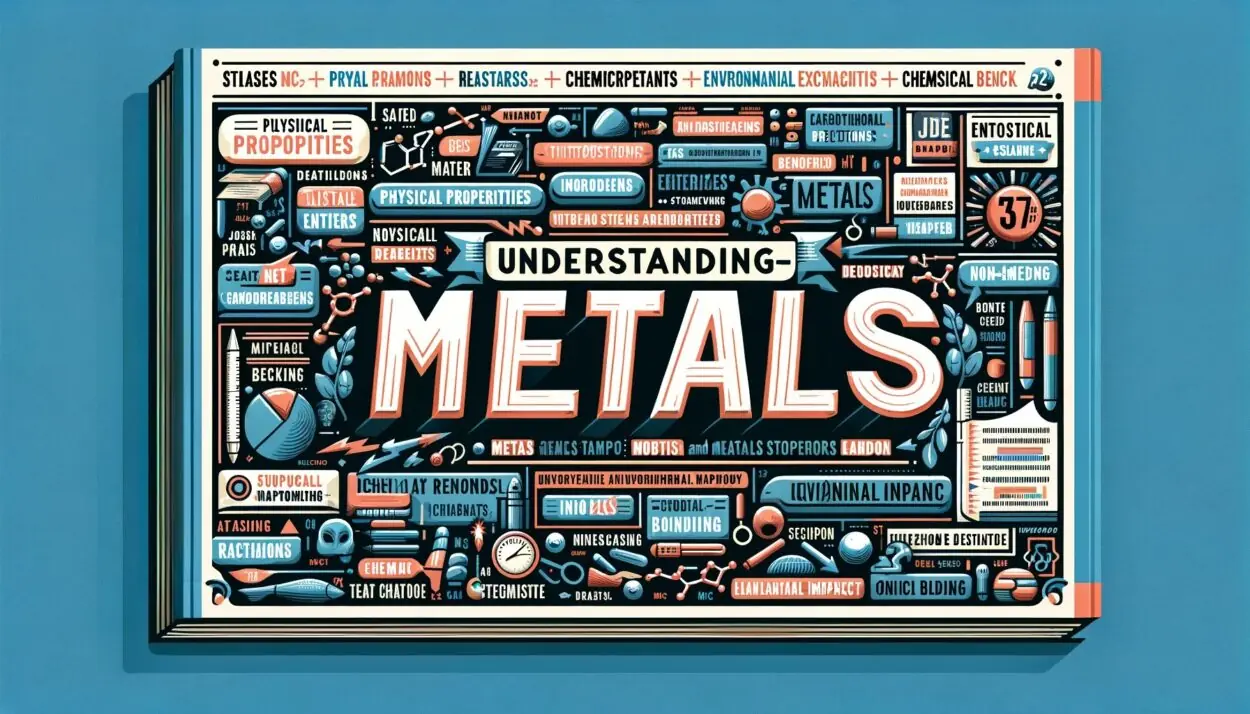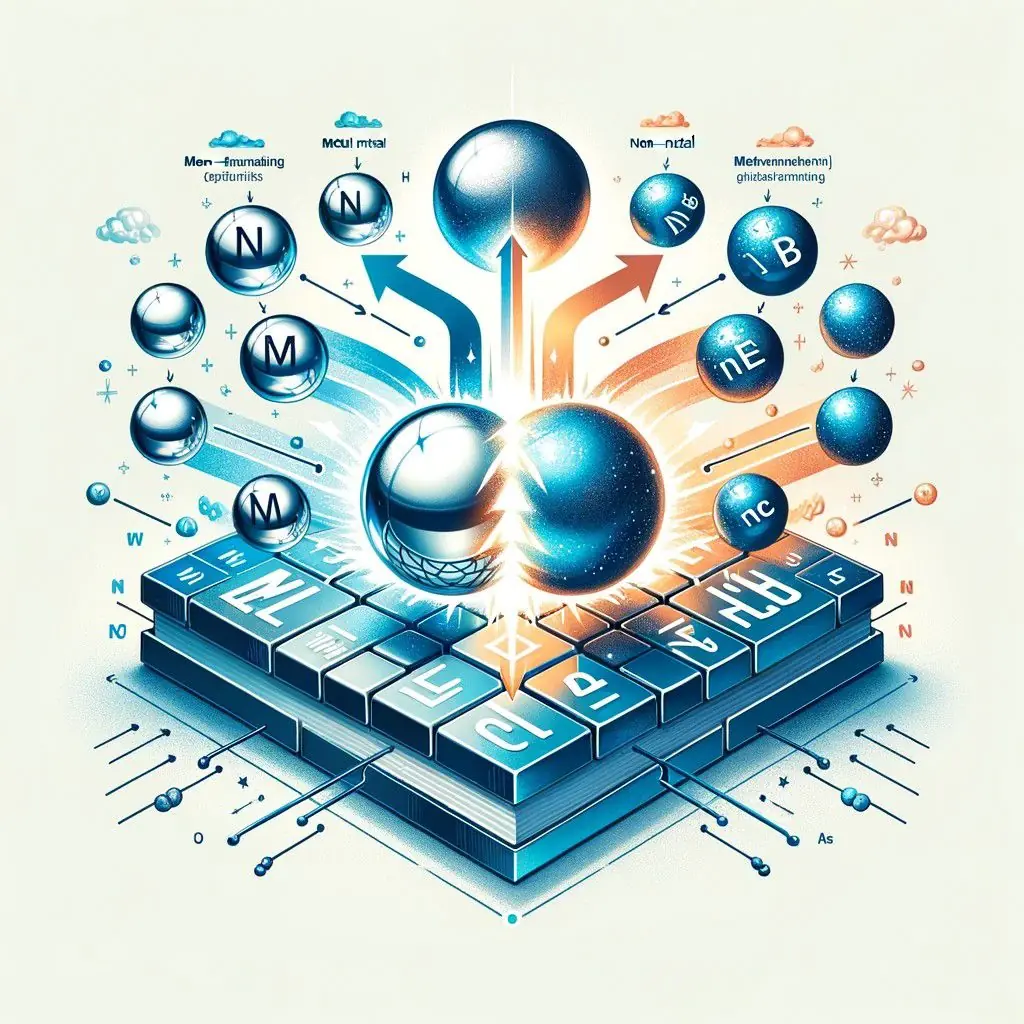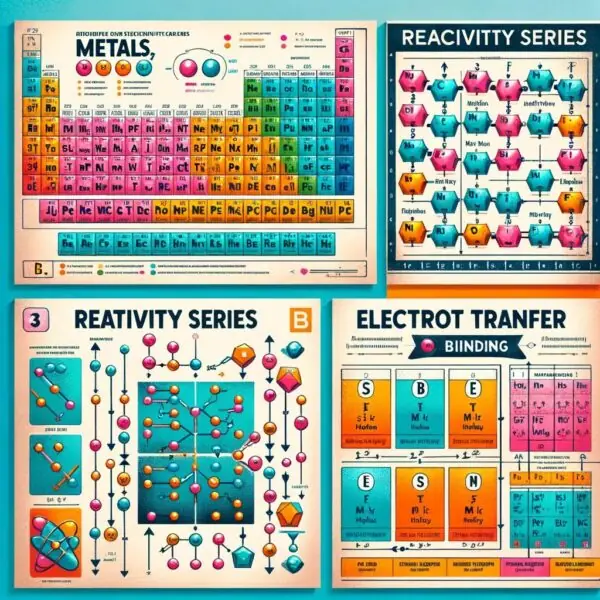
Understanding Metals and Non-Metals: A Comprehensive Guide for Class 10 NCERT Students

Introduction to Metals and Non-Metals
Understanding the Basics
Metals and non-metals are fundamental elements that make up our world. They exhibit distinct physical and chemical properties, which significantly impact their usage in various fields such as industry, technology, and daily life. This article aims to provide a comprehensive understanding of these elements, tailored for Class 10 students following the NCERT syllabus.
Physical Properties of Metals and Non-Metals
The Observable Differences
Metals:
- Lustrous Nature: Most metals have a shiny surface.
- Conductivity: Good conductors of heat and electricity.
- Malleability and Ductility: Can be hammered into thin sheets or drawn into wires.
- High Melting and Boiling Points: Generally possess high melting and boiling points.
- Density: Usually high density.
Non-Metals:
- Non-lustrous: Dull appearance, except for graphite which is lustrous.
- Poor Conductors: Generally poor conductors of heat and electricity.
- Brittle: Break or shatter easily.
- Low Density: Generally lower than metals.
- Low Melting and Boiling Points: Except for diamond, a form of carbon.
Chemical Properties of Metals and Non-Metals
How They React
Metals:
- Reaction with Oxygen: Form basic oxides.
- Reaction with Water: Some metals react vigorously with water, releasing hydrogen gas.
- Displacement Reactions: More reactive metals can displace less reactive ones from their compounds.
Non-Metals:
- Reaction with Oxygen: Form acidic or neutral oxides.
- Reaction with Metals: Gain electrons and form negative ions.
- Reaction with Hydrogen: Form hydrides.
Reaction of Metals with Non-Metals
Forming Compounds
When metals and non-metals react, they typically form ionic compounds. Metals lose electrons and form positive ions, while non-metals gain electrons and form negative ions.
Extraction of Metals
From Ore to Pure Metal
The extraction of metals from their ores involves several steps:
- Concentration of Ores: Removal of impurities.
- Reduction to Metal: Using suitable reducing agents.
- Refining: To obtain pure metal.
Corrosion
The Gradual Destruction
Corrosion is a process where metals are gradually destroyed through chemical reactions with their environment, like rusting of iron.
Prevention of Corrosion
Protecting the Metals
- Painting or Coating: Applying protective layers.
- Galvanization: Coating with zinc.
- Alloying: Mixing with other metals for increased resistance.
Conclusion
Metals and non-metals play a crucial role in our daily lives. Understanding their properties and reactions is essential for their effective utilization and conservation.

FAQs Section
Frequently Asked Questions About Metals and Non-Metals
- What is the main difference between metals and non-metals?
Metals are usually shiny, good conductors of heat and electricity, and can be shaped easily. Non-metals are generally dull, poor conductors, and brittle. - Can non-metals conduct electricity?
Most non-metals are poor conductors. However, graphite, a form of carbon, is a notable exception and conducts electricity. - Why do metals tend to lose electrons?
Metals have a lower attraction for their outer electrons, making it easier for them to lose these electrons during chemical reactions. - What are alloys and why are they important?
Alloys are mixtures of metals with other metals or non-metals, which improve properties like strength, corrosion resistance, or ductility. - How does corrosion affect metals?
Corrosion, like rusting in iron, leads to the deterioration of metals due to chemical reactions with the environment.
Interactive Quizzes
Test Your Knowledge
- Which of the following is a property of most metals?
a) Poor conductivity
b) Malleability
c) Brittleness
d) Low melting point - Galvanization is a method of protecting iron from rusting. What metal is used in galvanization?
a) Copper
b) Aluminium
c) Zinc
d) Silver - Which non-metal is known for its lustrous appearance?
a) Oxygen
b) Carbon in the form of graphite
c) Sulfur
d) Phosphorus
Real-World Applications
Metals and Non-Metals in Everyday Life
- Metals in Construction: Steel, an alloy of iron, is fundamental in building structures for its strength and durability.
- Non-Metals in Electronics: Silicon, a non-metal, is essential in the manufacturing of electronic chips.
- Medical Uses: Metals like titanium are used in surgical implants due to their biocompatibility.
Historical Context
The Discovery and Early Uses
- Iron Age: The period when iron was first used extensively in tools and weapons, marking a significant advancement in technology and civilization.
- Ancient Non-Metals: Sulfur and carbon, used since ancient times for various purposes like medicines and fuels.
Future Trends
Advancements and Sustainable Development
- Smart Materials: Research in smart alloys and non-metal compounds that can change properties in response to external stimuli.
- Green Technology: Metals and non-metals in renewable energy technologies, like solar cells and batteries.
Experiment and Observation Section
Hands-On Learning: Simple Experiments with Metals and Non-Metals
- Conductivity Test: Use a simple circuit with a battery and a bulb to test the conductivity of various metals and non-metals. Observe which materials light up the bulb, indicating good conductivity.
- Reaction with Acids: Safely test how different metals react with dilute acids like hydrochloric acid. Observe the rate of hydrogen gas production as a measure of reactivity.
- Observing Corrosion: Place iron nails in different environments: dry air, moist air, and saltwater. Observe and record the rate of rusting in each case over a few weeks.
Career Opportunities
Exploring Future Paths: Careers Involving Metals and Non-Metals
- Material Science: Developing new materials for various applications.
- Environmental Science: Studying the impact of metals and non-metals on the environment and finding sustainable solutions.
- Metallurgical Engineering: Involves the extraction, refining, and processing of metals.
Myth-Busting Section
Debunking Common Myths About Metals and Non-Metals
- Myth: All metals are magnetic.
Fact: Only a few metals like iron, nickel, and cobalt are magnetic. - Myth: Diamonds, being a form of carbon (non-metal), are not strong.
Fact: Diamonds are the hardest natural substance known. - Myth: Pure gold is the best for jewelry.
Fact: Pure gold is too soft for most jewelry; alloys with other metals are commonly used.
Inspirational Scientists
Great Minds in the Field of Metals and Non-Metals
- Dmitri Mendeleev: Creator of the Periodic Table, which revolutionized how we understand elements.
- Marie Curie: Pioneered research on radioactivity and discovered polonium and radium.
- Humphry Davy: Discovered several alkali and alkaline earth metals and studied the properties of chlorine.
Visual Aids
Charts and Diagrams
- Periodic Table: Highlighting the position and classification of metals, non-metals, and metalloids.
- Reactivity Series: A chart showing the reactivity order of different metals.
- Electron Transfer Diagrams: Visualizing the electron transfer in ionic bonding between metals and non-metals.
